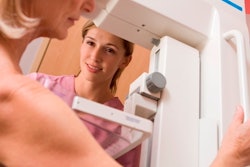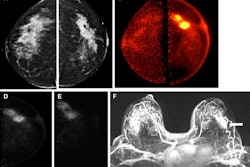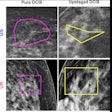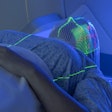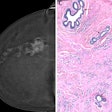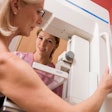Deep-learning models could have potential as predictive tools for breast cancer prognosis, a study published January 17 in Clinical Breast Cancer has found.
A team led by Junqi Han, MD, from the Affiliated Hospital of Qingdao University in China found that its model combining data from mammography images, ultrasound images, and other characteristics performed well in predicting disease-free survival of breast cancer.
“The combination of mammography and ultrasound images improved… performance for predicting breast cancer prognosis compared with single medical imaging modalities,” Han and colleagues wrote.
AI and deep learning continue to be explored by radiologists for their potential to improve breast cancer diagnosis and prognosis. Han and colleagues focused on the latter for their study, attempting to establish and validate their deep learning methods that combine mammography, ultrasound, and clinical data to predict prognosis in breast cancer.
The researchers included data from 1,242 patients recruited between 2013 and 2018 and divided them into training (n = 1,014) and testing groups (n = 228). They collected imaging data to establish deep-learning models using ResNet50. From there, the team used clinical data and imaging characteristics to select independent prognostic factors to establish a clinical model.
In total, the team developed five models: ultrasound deep learning, mammography deep learning, ultrasound plus mammography deep learning, a clinical model, and a combined model.
The researchers found that the combined model using images from both modalities, as well as pathological, clinical, and radiographic characteristics, had the highest predictive performance of the models analyzed. They used area under the receiver operating curve (AUC) to measure the predictive performance of the models.
| Comparison of models in breast cancer prognosis | |||||
|---|---|---|---|---|---|
| Measure | Ultrasound deep learning | Mammography deep learning | Ultrasound plus mammography deep learning | Clinical model | Combined model |
| AUC (training group) | 0.605 | 0.821 | 0.825 | 0.656 | 0.882 |
| AUC (testing group) | 0.683 | 0.674 | 0.699 | 0.538 | 0.739 |
The team, however, noted that certain pathological and clinical characteristics could only be obtained after surgery. This means the combined model could predict prognosis after surgery.
The study authors also highlighted the “complementary” abilities of ultrasound and mammography in breast imaging.
“Ultrasound is used to observe the shape and internal characteristics of lesions, and mammography is used to observe calcification,” they wrote. “Therefore, combining the high-throughput characteristics of [both modalities] with deep learning was useful for predicting prognosis in patients with breast cancer.”
Han and colleagues also called for future studies to perform external validation based on an independent validation group to prove the predictive effectiveness and generalizability of the models.
The full study can be found here.




